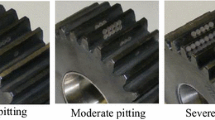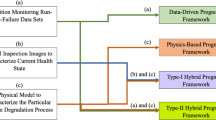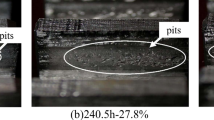Abstract
The surface/subsurface-initiated pitting is one of the most common failure modes in a gear. Although models for predicting the initiation of pitting are available, a model for predicting the growth of an existing pitting is not yet available. The present work proposes a hybrid prognosis approach for estimating the growth of pitting on the gear tooth surface, utilizing both empirical model (i.e., modified Paris law) and measured pitting area. The proposed approach is generic as the pitting growth rate is modelled as a function of gear material properties (such as Poisson’s ratio and modulus of elasticity), oil property (such as dynamic viscosity), gear geometrical parameters (such as pitch circle diameter, module, pressure angle and face width) and operating conditions (such as applied load and speed). The pitting evolution process is likely to be different for similar gear pairs due to inherent variations in material properties, manufacturing process, etc. Hence for a more accurate life prediction, the pit growth model parameters need to be updated, which is done using Bayesian inference.















Similar content being viewed by others
References
Al-Tubi, I. S., & Long, H. (2013). Prediction of wind turbine gear micropitting under variable load and speed conditions using ISO/TR 15144–1: 2010. Proceedings of the Institution of Mechanical Engineers, Part c: Journal of Mechanical Engineering Science, 227(9), 1898–1914. https://doi.org/10.1177/0954406212469593
Amarnath, M., & Sujatha, C. (2015). Surface contact fatigue failure assessment in spur gears using lubricant film thickness and vibration signal analysis. Tribology Transactions, 58, 327–336. https://doi.org/10.1080/10402004.2014.971993
An, D., Choi, J. H., & Kim, N. H. (2013). Prognostics 101: a tutorial for particle filter-based prognostics algorithm using Matlab. Reliability Engineering and System Safety, 115, 161–169. https://doi.org/10.1016/j.ress.2013.02.019
Aslantaş, K., & Taşgetiren, S. (2004). A study of spur gear pitting formation and life prediction. Wear, 257, 1167–1175. https://doi.org/10.1016/j.wear.2004.08.005
Blake, J. W., & Cheng, H. S. (1991). A surface pitting life model for spur gears: part I—Life prediction. Journal of Tribology, 113, 712–718. https://doi.org/10.1115/1.2920683
Budynas, R., & Nisbett, J. K. (2015). Shigley’s mechanical engineering design (10th ed.). McGraw-Hill Education.
Castro, J., & Seabra, J. (2007). Coefficient of friction in mixed film lubrication: gears versus twin-discs. Proceedings of the Institution of Mechanical Engineers, Part j: Journal of Engineering Tribology, 221(3), 399–411. https://doi.org/10.1243/13506501JET257
Cubillo, A., Perinpanayagam, S., & Esperon-Miguez, M. (2016). A review of physics-based models in prognostics: application to gears and bearings of rotating machinery. Advances in Mechanical Engineering, 8, 1–21. https://doi.org/10.1177/1687814016664660
Davis, J. R. (2005). Gear materials, properties, and manufacture. ASM International.
Ding, Y., & Rieger, N. F. (2003). Spalling formation mechanism for gears. Wear, 254, 1307–1317. https://doi.org/10.1016/S0043-1648(03)00126-1
Fajdiga, G., Flašker, J., & Glodež, S. (2004). The influence of different parameters on surface pitting of contacting mechanical elements. Engineering Fracture Mechanics, 71, 747–758. https://doi.org/10.1016/S0013-7944(03)00022-5
Fajdiga, G., Flašker, J., Glodež, S., & Hellen, T. K. (2003). Numerical modelling of micro-pitting of gear teeth flanks. Fatigue and Fracture of Engineering Materials and Structures, 26, 1135–1143. https://doi.org/10.1046/j.1460-2695.2003.00711.x
Forman, R. G., Kearney, V. E., & Engle, R. M. (1967). Numerical analysis of crack propagation in cyclic-loaded structures. Journal of Basic Engineering, 89, 459–463. https://doi.org/10.1115/1.3609637
Glodež, S., Ren, Z., & Flašker, J. (1999). Surface fatigue of gear teeth flanks. Computers & Structures, 73, 475–483. https://doi.org/10.1016/S0045-7949(98)00251-X
Heng, A., Zhang, S., Tan, A. C. C., & Mathew, J. (2009). Rotating machinery prognostics: State of the art, challenges and opportunities. Mechanical Systems and Signal Processing, 23, 724–739. https://doi.org/10.1016/j.ymssp.2008.06.009
Hertz, H. (1881). On the contact of elastic solids. Mathematik., 92, 156–171.
Hoeprich, M. R. (1992). Rolling element bearing fatigue damage propagation. Journal of Tribology, 114, 328–333. https://doi.org/10.1115/1.2920891
ISO/TR 15144–1:2014. (2014). Calculation of micropitting load capacity of cylindrical spur and helical gears—Part 1: Introduction and basic principles. ISO: Geneva, Switz (pp. 1–35) (2014).
Kaneta, M., Murakami, Y., & Okazaki, T. (1986). Growth mechanism of subsurface crack due to hertzian contact. Journal of Tribology, 108, 134–139. https://doi.org/10.1115/1.3261133
Kundu, P., Darpe, A. K., & Kulkarni, M. S. (2019). A correlation coefficient based vibration indicator for detecting natural pitting progression in spur gears. Mechanical Systems and Signal Processing, 129, 741–763. https://doi.org/10.1016/j.ymssp.2019.04.058
Kundu, P., Darpe, A. K., & Kulkarni, M. S. (2020a). A review on diagnostic and prognostic approaches for gears. Structural Health Monitoring. https://doi.org/10.1177/1475921720972926
Kundu, P., Darpe, A. K., & Kulkarni, M. S. (2020b). An ensemble decision tree methodology for remaining useful life prediction of spur gears under natural pitting progression. Structural Health Monitoring, 19(3), 854–872. https://doi.org/10.1177/1475921719865718
Kundu, P., Darpe, A. K., & Kulkarni, M. S. (2020c). Gear pitting severity level identification using binary segmentation methodology. Structural Control and Health Monitoring, 27(3), e2478. https://doi.org/10.1002/stc.2478
Li, S., & Kahraman, A. (2014). A micro-pitting model for spur gear contacts. International Journal of Fatigue, 59, 224–233. https://doi.org/10.1016/j.ijfatigue.2013.08.015
Li, Y., Billington, S., Zhang, C., Kurfess, T., Danyluk, S., & Liang, S. (1999). Adaptive prognostics for rolling element bearing condition. Mechanical Systems and Signal Processing, 13, 103–113. https://doi.org/10.1006/mssp.1998.0183
Li, Y., Kurfess, T. R., & Liang, S. Y. (2000). Stochastic prognostics for rolling element bearings. Mechanical Systems and Signal Processing, 14, 747–762. https://doi.org/10.1006/mssp.2000.1301
Liu, H., Liu, H., Zhu, C., & Zhou, Y. (2019). A review on micropitting studies of steel gears. Coatings, 42, 1–27. https://doi.org/10.3390/coatings9010042
Moallem, H., Akbarzadeh, S., & Ariaei, A. (2016). Prediction of micropitting life in spur gears operating under mixed-lubrication regime using load-sharing concept. Proceedings of the Institution of Mechanical Engineers, Part j: Journal of Engineering Tribology, 230(5), 591–599. https://doi.org/10.1177/1350650115607896
Norton, R. L. (2011). Machine design: an integrated approach (4th ed.). Pearson Education Inc. https://doi.org/10.1115/1.2472416
Orchard, M. E., & Vachtsevanos, G. J. (2007). A Particle filtering approach for on-line failure prognosis in a planetary carrier plate. International Journal of Fuzzy Logic and Intelligent Systems, 7(4), 221–227. https://doi.org/10.5391/IJFIS.2007.7.4.221
Paris, P. C., Gomez, M. P., & Anderson, W. E. (1961). A rational analytic theory of fatigue. Trend Eng., 13, 9–14.
Radzimovsky, E. I. (1953). Stress distribution and strength condition of two rolling cylinders pressed together. University of Illinois at Urbana Champaign, College of Engineering. Engineering Experiment Station 50.
Rycerz, P., Olver, A., & Kadiric, A. (2017). Propagation of surface initiated rolling contact fatigue cracks in bearing steel. International Journal of Fatigue, 97, 29–38. https://doi.org/10.1016/j.ijfatigue.2016.12.004
Stanković, M., Marinković, A., Grbović, A., Mišković, Ž, Rosić, B., & Mitrović, R. (2019). Determination of Archard’s wear coefficient and wear simulation of sliding bearings. Industrial lubrication and Tribology, 71, 119–125. https://doi.org/10.1108/ILT-08-2018-0302
Tan, C. K., Irving, P., & Mba, D. (2007). A comparative experimental study on the diagnostic and prognostic capabilities of acoustics emission, vibration and spectrometric oil analysis for spur gears. Mechanical Systems and Signal Processing, 21, 208–233. https://doi.org/10.1016/j.ymssp.2005.09.015
Wang, J., Wang, P., & Gao, R. X. (2015). Enhanced particle filter for tool wear prediction. Journal of Manufacturing Systems, 36, 35–45. https://doi.org/10.1016/j.jmsy.2015.03.005
Winter, H., & Michaelis, K. (1984). Scoring load capacity of gears lubricated with EP-Oils. Gear Technollogy, 20–45.
Yin, Y., Chen, Y.-X., & Liu, L. (2017). Lifetime prediction for the subsurface crack propagation using three-dimensional dynamic FEA model. Mechanical Systems and Signal Processing, 87, 54–70. https://doi.org/10.1016/j.ymssp.2016.09.033
Zhu, D., Ren, N., & Wang, Q. J. (2009). Pitting life prediction based on a 3D line contact mixed EHL analysis and subsurface von Mises stress calculation. Journal of Tribology, 131, 1–8. https://doi.org/10.1115/1.3195040
Zio, E., & Peloni, G. (2011). Particle filtering prognostic estimation of the remaining useful life of nonlinear components. Reliability Engineering and System Safety, 96, 403–409. https://doi.org/10.1016/J.RESS.2010.08.009
Acknowledgements
The authors gratefully acknowledge the financial support extended by the Aeronautics Research and Development Board, D.R.D.O., Government of India (project grant no. ARDB/01/1071913/M/I).
Author information
Authors and Affiliations
Corresponding author
Additional information
Publisher's Note
Springer Nature remains neutral with regard to jurisdictional claims in published maps and institutional affiliations.
Rights and permissions
About this article
Cite this article
Kundu, P., S.Kulkarni, M. & K.Darpe, A. A hybrid prognosis approach for life prediction of gears subjected to progressive pitting failure mode. J Intell Manuf 34, 1325–1346 (2023). https://doi.org/10.1007/s10845-021-01852-6
Received:
Accepted:
Published:
Issue Date:
DOI: https://doi.org/10.1007/s10845-021-01852-6




